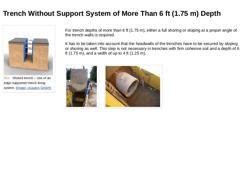
|
(Image: Shored trench – Use of an edge-supported trench lining system) For trench depths of more than 6 ft (1.75 m), either a full shoring or sloping at a proper angle of the trench walls is required. It has to be taken into account that the headwalls of the trenches have to be secured by sloping or shoring as well. This step is not necessary in trenches with firm cohesive soil and a depth of 6 ft (1.75 m), and a width of up to 4 ft (1.25 m). (Image: … |
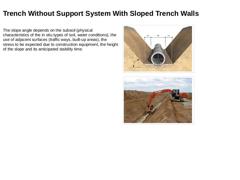
|
The slope angle depends on the subsoil (physical characteristics of the in situ types of soil, water conditions), the use of adjacent surfaces (traffic ways, built-up areas), the stress to be expected due to construction equipment, the height of the slope and its anticipated stability time. (Image: Slope angle and working space width according to DWA-A 139) (Image: Trench without support system with a slope angle of ß = 45° and minimum distance to … |
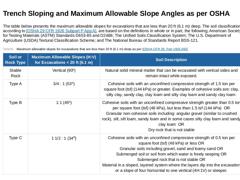
|
The table below presents the maximum allowable slopes for excavations that are less than 20 ft (6.1 m) deep. The soil classification, according to [[OSHA 29 CFR 1926 Subpart P App A]], are based on the definitions in whole or in part, the following; American Society for Testing Materials (ASTM) Standards D653-85 and D2488; The Unified Soils Classification System; The U.S. Department of Agriculture (USDA) Textural Classification Scheme; and The National … |
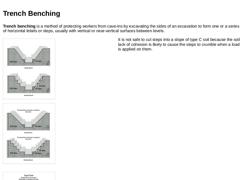
|
Trench benching is a method of protecting workers from cave-ins by excavating the sides of an excavation to form one or a series of horizontal levels or steps, usually with vertical or near-vertical surfaces between levels. (Image: Benching with allowable slopes and step hight for type A soil according to OSHA) (Image: Benching with allowable slopes and step hight for type B soil according to OSHA) It is not safe to cut steps into a slope of type C … |
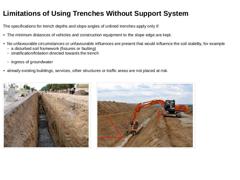
|
The specifications for trench depths and slope angles of unlined trenches apply only if: |
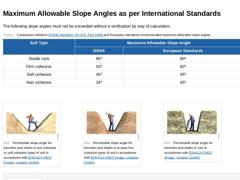
|
The following slope angles must not be exceeded without a verification by way of calculation. (Table: Maximum allowable slope angle comparison) (Image: Permissible slope angle for trenches and shafts in non-cohesive or soft cohesive types of soil in accordance with [DIN4124c]) (Image: Permissible slope angle for trenches and shafts in at least firm cohesive types of soil in accordance with [DIN4124c]) (Image: Permissible slope angle for trenches and … |
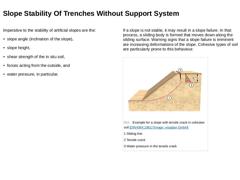
|
Imperative to the stability of artificial slopes are the: -
slope angle (inclination of the slope),
-
slope height,
-
shear strength of the in situ soil,
-
forces acting from the outside, and
-
water pressure, in particular.
If a slope is not stable, it may result in a slope failure. In that process, a sliding body is formed that moves down along the sliding surface. Warning signs that a slope failure is imminent are increasing deformations of the slope. … |
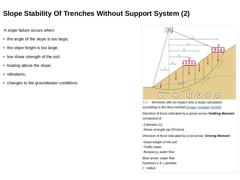
|
A slope failure occurs when: -
the angle of the slope is too large;
-
the slope height is too large;
-
low shear strength of the soil;
-
loading above the slope;
-
vibrations;
-
changes to the groundwater conditions.
(Image: Moments with an impact onto a slope calculation according to the slice method) |
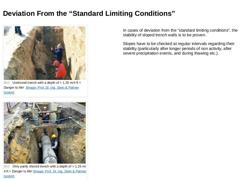
|
(Image: Unshored trench with a depth of > 1.25 m/4 ft = Danger to life!) (Image: Only partly shored trench with a depth of > 1.25 m/4 ft = Danger to life!) In cases of deviation from the “standard limiting conditions”, the stability of sloped trench walls is to be proven. Slopes have to be checked at regular intervals regarding their stability (particularly after longer periods of non activity, after severe precipitation events, and during thawing … |
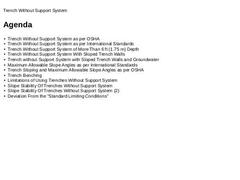
|
|
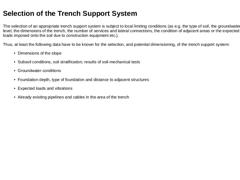
|
The selection of an appropriate trench support system is subject to local limiting conditions (as e.g. the type of soil, the groundwater level, the dimensions of the trench, the number of services and lateral connections, the condition of adjacent areas or the expected loads imposed onto the soil due to construction equipment etc.). Thus, at least the following data have to be known for the selection, and potential dimensioning, of the trench support … |
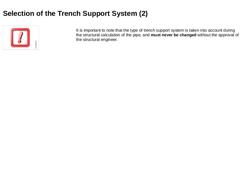
|
It is important to note that the type of trench support system is taken into account during the structural calculation of the pipe, and must never be changed without the approval of the structural engineer. |
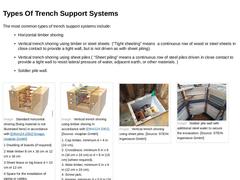
|
The most common types of trench support systems include: -
Horizontal timber shoring
-
Vertical trench shoring using timber or steel sheets (“Tight sheeting” means a continuous row of wood or steel sheets in close contact to provide a tight wall, but is not driven as with sheet piling)
-
Vertical trench shoring using sheet piles ( “Sheet piling” means a continuous row of steel piles driven in close contact to provide a tight wall to resist lateral pressure …
|
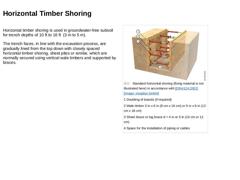
|
Horizontal timber shoring is used in groundwater-free subsoil for trench depths of 10 ft to 16 ft (3 m to 5 m). The trench faces, in line with the excavation process, are gradually lined from the top down with closely spaced horizontal timber shoring, sheet piles or similar, which are normally secured using vertical wale timbers and supported by braces. (Image: Standard horizontal shoring (fixing material is not illustrated here) in accordance with [… |
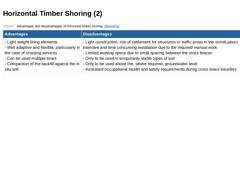
|
(Table: Advantages and disadvantages of horizontal timber shoring) |
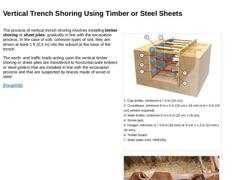
|
The process of vertical trench shoring involves installing timber shoring or sheet piles gradually in line with the excavation process. In the case of soft, cohesive types of soil, they are driven at least 1 ft (0.3 m) into the subsoil at the base of the trench. The earth- and traffic loads acting upon the vertical timber shoring or sheet piles are transferred to horizontal wale timbers or steel girders that are installed in line with the excavation … |
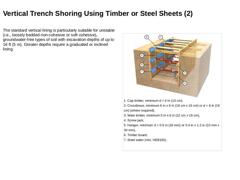
|
The standard vertical lining is particularly suitable for unstable (i.e., loosely bedded non-cohesive or soft cohesive), groundwater-free types of soil with excavation depths of up to 16 ft (5 m). Greater depths require a graduated or inclined lining. (Image: Vertical trench shoring using timber shoring in accordance with [DIN4124:2002]) |
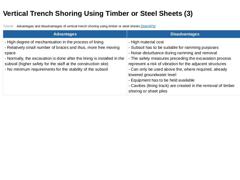
|
(Table: Advantages and disadvantages of vertical trench shoring using timber or steel sheets) |
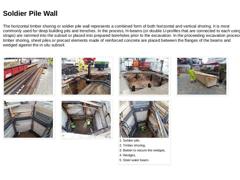
|
The horizontal timber shoring or soldier pile wall represents a combined form of both horizontal and vertical shoring. It is most commonly used for deep building pits and trenches. In the process, H-beams (or double U-profiles that are connected to each using straps) are rammed into the subsoil or placed into prepared boreholes prior to the excavation. In the proceeding excavation process, timber shoring, sheet piles or precast elements made of reinforced … |
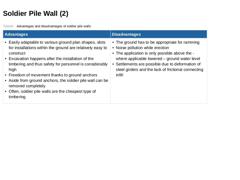
|
(Table: Advantages and disadvantages of soldier pile walls) |
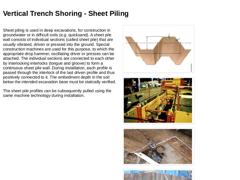
|
Sheet piling is used in deep excavations, for construction in groundwater or in difficult soils (e.g. quicksand). A sheet pile wall consists of individual sections (called sheet pile) that are usually vibrated, driven or pressed into the ground. Special construction machines are used for this purpose, to which the appropriate drop hammer, oscillating driver or presses can be attached. The individual sections are connected to each other by interlocking … |
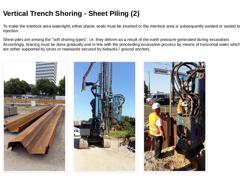
|
To make the interlock area watertight, either plastic seals must be inserted or the interlock area is subsequently welded or sealed by injection. Sheet piles are among the "soft shoring types", i.e. they deform as a result of the earth pressure generated during excavation. Accordingly, bracing must be done gradually and in line with the proceeding excavation process by means of horizontal waler which are either supported by struts or rearwards secured … |
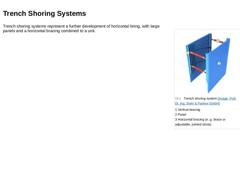
|
(Image: Trench shoring system) Trench shoring systems represent a further development of horizontal lining, with large panels and a horizontal bracing combined to a unit. |
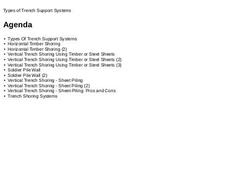
|
|
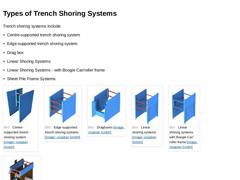
|
Trench shoring systems include: -
Centre-supported trench shoring system
-
Edge-supported trench shoring system
-
Drag box
-
Linear Shoring Systems
-
Linear Shoring Systems - with Boogie Car/roller frame
-
Sheet Pile Frame Systems
(Image: Centre-supported trench shoring system) (Image: Edge-supported trench shoring systems) (Image: Dragboxes) (Image: Linear shoring systems) (Image: Linear shoring systems with Boogie Car/roller frame) (Image: Sheet Pile Frame … |